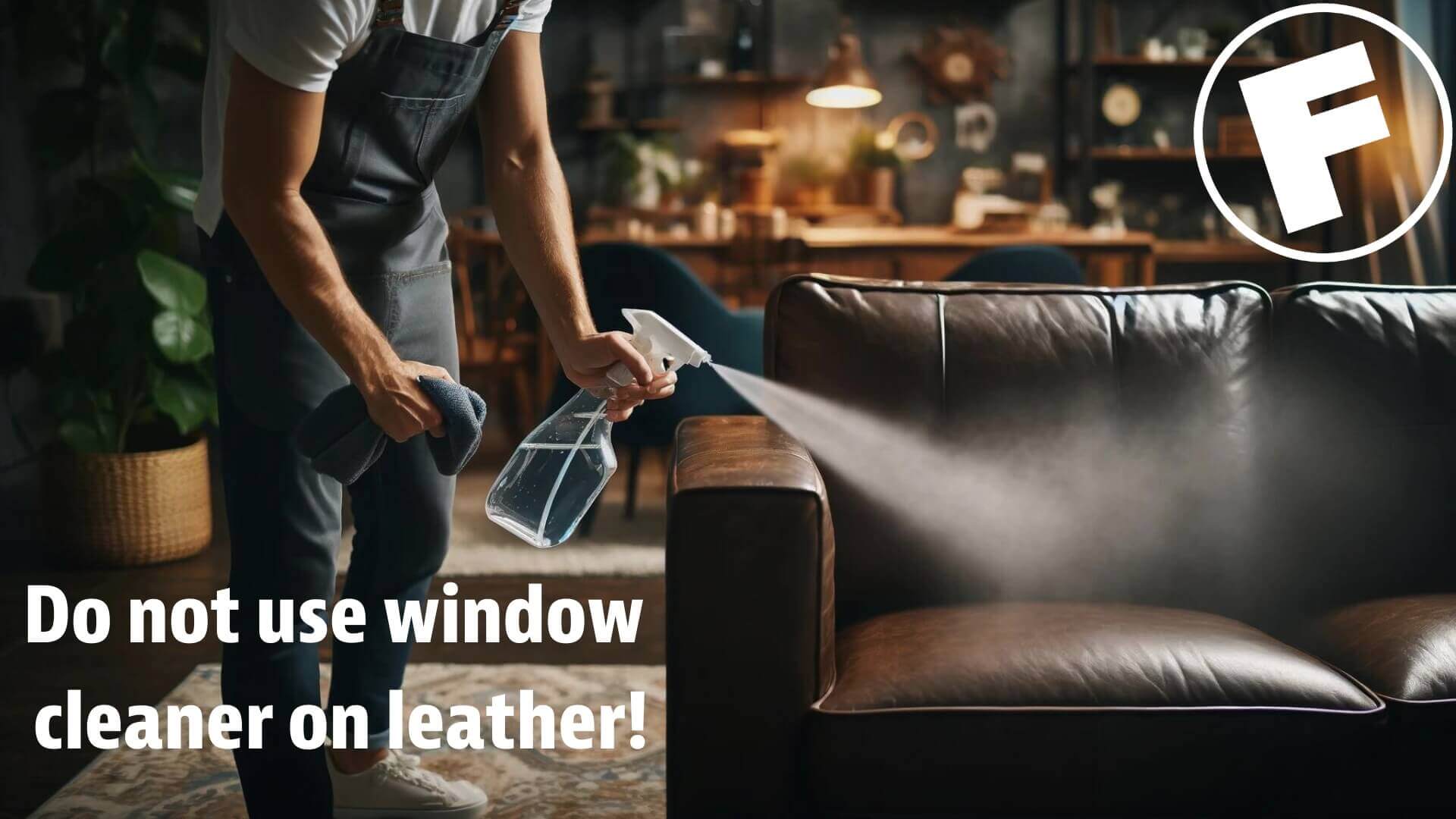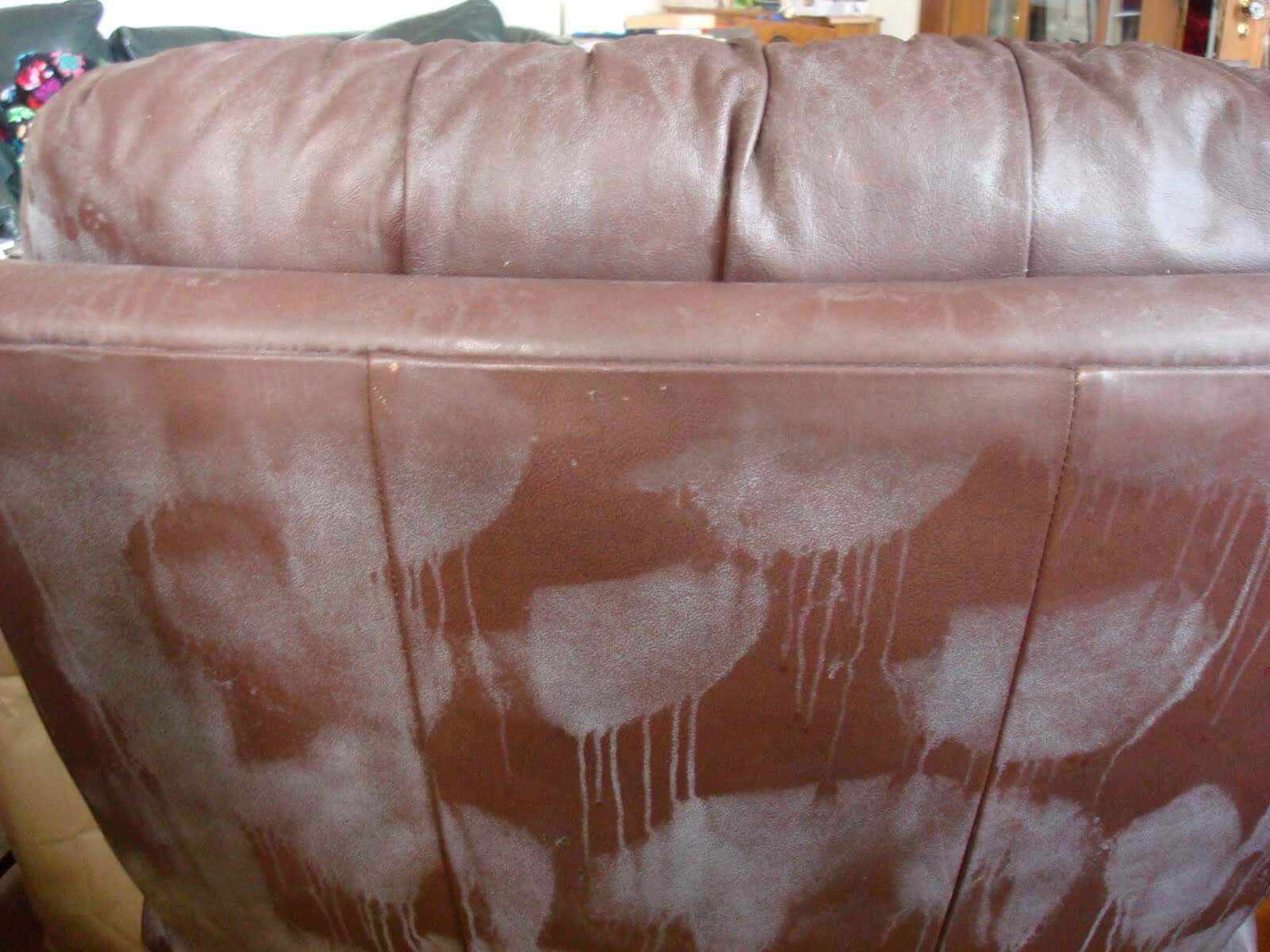Do Not Use Window Cleaner on Leather
Many people think of window cleaner or glass cleaner—Windex and its contemporaries—as being one of the mildest of all cleaning products. People consider it to be so mild they could use it on almost anything.
Unfortunately, you really cannot use window cleaner on leather couch, leather car seats, and any other leather products because almost all of it contains alcohol.

There are a number of other home remedies and wives’ tales about using home products on leather. We do not advise using any of the following:
- Olive oil
- Beeswax
- Hair spray
- Markers
- Shoe polish
- Finger nail polish remover
- Disposable cleaning supplies and wipes
Alcohol will damage the surface of your leather, especially breaking down the protective top coat on fully-finished leathers that make up the vast majority of the leather upholstery market.
Breakdown of this surface will leave your upholstery more susceptible to all types of damage in the future, like scratching and water damage.
Alcohol can also, in some cases, cause discoloration in leather.

Yup. Alcohol can do this to your favorite couch.
Why not to use window cleaner on leather
If you’ve ever glanced around your home in search of a quick-fix DIY solution to clean your leather furniture or accessories, you might have been tempted to reach for that trusty bottle of window cleaner.
It’s a common household cleaner, after all. But hold on just a moment! Before you spritz, squirt, or splash that blue liquid onto your precious leather, let’s have a quick chat about why that’s a big no-no.
- Harsh Chemicals: Window cleaners are designed to tackle tough grease and grime on glass surfaces. They contain potent chemicals like ammonia and alcohol, which can wreak havoc on delicate leather. These abrasive substances can strip away the natural oils in the leather, leaving it dry, brittle, and prone to cracking.
- Color Damage: Leather comes in various colors and finishes, each requiring specific care. Window cleaners aren’t discriminative in their cleaning approach. They can dull the color of your leather or, in worst-case scenarios, cause discoloration or staining. Imagine your sleek black leather sofa transformed into a patchy, faded mess. Not a pretty picture, right?
- Loss of Luster: Leather has a natural sheen and texture that adds to its allure. Using window cleaner can dull this luster, leaving your leather looking lackluster and lifeless. Say goodbye to that luxurious shine you fell in love with when you first brought home your leather goods.
- Long-Term Damage: The effects of using window cleaner on leather might not be immediately noticeable, but they can accumulate over time. Continuous use can lead to irreversible damage, causing your once pristine leather to become cracked, stiff, and unattractive. It’s like slowly chipping away at the beauty and integrity of your beloved leather possessions.
- Safer Alternatives Exist: Instead of risking your leather’s well-being with window cleaner, opt for safer alternatives specifically formulated for leather care. Look for mild, pH-balanced leather cleaners that gently remove dirt and stains without compromising the leather’s quality. Additionally, using a leather conditioner can help replenish lost oils and maintain the leather’s suppleness.
How to clean leather surfaces safely and properly
Here’s a really qucik step-by-step for you. For a more in-depth tutorial, check here.
Materials needed
- Soft cloth or microfiber cloth
- Mild soap (like dish soap or castile soap)
- Water
- Leather conditioner
- Small bowl
- Optional: white vinegar
Steps
- Dust the Surface:
- Use a dry, clean cloth to remove any loose dust or dirt from the leather surface. Be gentle to avoid scratching the leather. This step ensures that you don’t rub dirt into the leather during cleaning, which could cause abrasion.
- Prepare the Cleaning Solution:
- Mix a few drops of mild soap with lukewarm water in a small bowl. You can add a tablespoon of white vinegar to the mixture if the leather is particularly dirty or has stubborn spots. The soap helps to lift dirt and oils, while the vinegar can help break down tougher stains without harming the leather.
- Test a Small Area:
- Before applying the cleaning solution to the entire surface, test it on a small, inconspicuous area of the leather. This is to ensure that the solution does not cause discoloration or damage. Apply a little of the solution, wait a few minutes, and then check the area.
- Clean the Leather:
- Dampen a soft cloth with the soapy water solution. Ensure the cloth is not too wet; it should be just damp to avoid soaking the leather, which can cause damage.
- Gently wipe the leather surface using light, circular motions. Work in small sections to ensure even cleaning. Be careful around seams and stitching, as too much water can weaken the threads over time.
- Rinse and Dry:
- Use a separate cloth dampened with plain water to wipe away any soap residue. This step is crucial to prevent any soapy buildup, which can attract more dirt and potentially dry out the leather.
- Immediately dry the surface with a clean, dry cloth. Pat the leather gently to remove any remaining moisture. Avoid rubbing harshly, which can damage the leather.
- Condition the Leather:
- Apply a leather conditioner to keep the leather supple and prevent it from drying out. Follow the instructions on the conditioner product. Typically, you will apply a small amount to a cloth and rub it into the leather in a circular motion.
- Conditioning helps replenish the natural oils in the leather, maintaining its softness and preventing cracks.
- Buff the Surface:
- After the conditioner has absorbed (usually 10-15 minutes), buff the leather with a soft cloth to restore its shine. This step gives the leather a polished look and helps distribute the conditioner evenly.
Cleaning tips
- Avoid Harsh Chemicals: Never use bleach, ammonia, or harsh chemical cleaners on leather, as they can cause significant damage.
- Regular Maintenance: Dust and condition leather surfaces regularly, ideally every 3-6 months, to maintain their appearance and longevity.
- Protect from Sunlight: Keep leather away from direct sunlight and heat sources to prevent it from drying out and cracking. UV rays can fade the color and damage the leather.
- Handle Stains Promptly: Address spills and stains as soon as they occur. Blot (don’t rub) with a dry cloth to absorb as much as possible before cleaning.
Let Fibrenew take care of your leather care needs
Get in touch with your local Fibrenew professional for all your leather, plastic, and vinyl repair needs.
Want to run a business that gives you incredible earning potential and the flexibility to take control of your time and life? Join the Fibrenew Family!
Check out our free Franchise Information Report for everything you need to know.
Also, enjoy these valuable resources on all things leather, plastic, and vinyl repair, franchising, sustainability, and more:
Stay tuned!
What makes window cleaner harmful to leather? Window cleaners often contain harsh chemicals such as ammonia and alcohol, which can strip away the natural oils in leather, leading to dryness and damage. Will using window cleaner on leather cause immediate damage? While immediate damage may not be evident, the long-term effects can be detrimental. Continuous use of window cleaner can lead to discoloration, loss of luster, and eventual cracking of the leather. Can window cleaner cause staining on leather? Yes, window cleaner can cause staining on leather, especially if it contains dyes or other additives that react with the leather’s surface, resulting in unsightly marks or discoloration. How does window cleaner affect the color of leather? Window cleaner can dull the color of leather and, in some cases, cause fading or uneven patches, altering the appearance of your leather goods. Will using window cleaner on leather make it more prone to cracking? Yes, the harsh chemicals in window cleaner can strip away the natural oils that keep leather supple and flexible, making it more susceptible to cracking and deterioration over time. Is there a risk of losing the natural sheen of leather when using window cleaner? Absolutely. Window cleaner can dull the natural luster of leather, leaving it looking dull and lifeless instead of maintaining its luxurious shine. Can using window cleaner on leather lead to irreversible damage? Yes, continuous use of window cleaner on leather can lead to irreversible damage, including cracking, stiffness, and a loss of the leather’s integrity. Are there safer alternatives to window cleaner for cleaning leather? Yes, there are plenty of leather-specific cleaners and conditioners available on the market that are formulated to clean and protect leather without causing damage. How should I clean leather instead of using window cleaner? Opt for mild, pH-balanced leather cleaners that are specifically designed for leather care. Follow up with a leather conditioner to replenish lost oils and maintain the leather’s suppleness. Can I use household products as alternatives to window cleaner for cleaning leather?Window cleaner on leather FAQ


